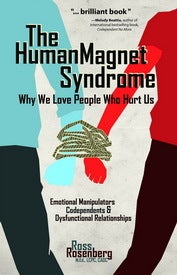
In my Human Magnet Syndrome: Why We Love People who Hurt Us (HMS)” book, I use the term “Narcissistic Injury” to explain the Pathological Narcissist’s reaction to perceived or real criticism, boundaries placed on them and/or attempts to hold them accountable for their harmful behavior. A narcissistic injury also occurs when a person refuses to accommodate their dysfunctional partner’s incessant need for admiration, special privileges, praise, etc. The narcissist’s loss of control over their emotions (emotional dysregulation), and the consequent behavioral reactions, are part and parcel to what we know as a narcissistic injury.

In HMS, I explain how codependency is caused by attachment trauma, which is then responsible for core shame and pervasive loneliness. As much as I make a case for the distressing nature of attachment trauma to the child who will become an adult codependent, the agonizing experience for the child who is to become a Pathological Narcissist is far worse; there is no comparison.
In HMS’ chapter, The Origins of Pathological Narcissism, I explained that the massive abuse, neglect and/or deprivation perpetrated by both the Pathological Narcissist and codependent parents results in psychological trauma of the highest degree. To emotionally survive this anguish, the child’s mind reacts in a manner similar to adult victims of Post-Traumatic Stress Disorder (PTSD). Hence, the attachment trauma is neatly packaged in what I refer to as a “hermetically sealed memory container,” and placed in a part of the brain (the amygdala) that does not release the memory to one’s conscious experience.
Right under the narcissist’s thinly veiled psychological “surface” lies the deeper reservoir of self-loathing and core shame. Although the attachment trauma memories are blocked from the narcissist’s conscious recollection, they show their “ugly face” during narcissistic injuries. Despite the brain’s best efforts to keep the attachment trauma permanently sealed off, there is “leakage.” Since our brain was designed through the imperfect process of evolution, and not by computer programmers, neurologists, or mechanical engineers, defense mechanisms by themselves are not able to keep the attachment trauma from “bubbling up” into the narcissist’s conscious mind.
Defense mechanisms protect pathological narcissists from realizing the truth about their highly traumatized and mentally impaired selves. It is a form of protective amnesia that wards off psychological harm, or emotional dysregulation, through the active use of psychological processes such as suppression, repression and dissociation (explained in HMS). The bubbling up, or surfacing, of the trauma manifests itself as feelings of rage and vindictive hatred for the instigator of the narcissistic injury. These reactions are unconsciously (biologically) designed to protect the narcissist from feeling the deep reservoir of core shame that has been blocked from their conscious mind.
Pathological narcissists are almost always oblivious to the core experience of a narcissistic injury. Feeling “bad,” “broken,” and/or “never good enough,” like they did as a child is simply not possible for the Personality Disordered narcissist. Therefore, the narcissistic injuries are disassociated feelings of self-hatred and self-loathing that are projected onto the offending person. These projections also manifest themselves as an offensive attack strategy designed to neutralize the person who they believe harbors judgments and criticisms against them and, therefore, are unconsciously experienced as untrustworthy and dangerous.
Narcissistic injuries are almost always projections, which is the misplacement of the narcissist’s unconscious self-hatred onto any person who they experience as threatening. Such threats come in variety of “sizes,” ranging from a disapproving glance to kick in the shin. Narcissistic injuries even happen when the recipient of the abuse does absolutely nothing. It is often the perception of disapproval and judgment that causes the internal emotional meltdown, not the real thing!
Consequently, narcissistic injuries provoke an internal fury that incites punishing pronouncements, judgments, and actions against the perceived perpetrator. Whether it is yelling, threatening, or even highly dangerous aggressive actions, narcissistic injuries are unnerving to many, and downright frightening to most. The only real cure for them is to find an exit route out of the relationship, while committing oneself to recovering from Self-Love Deficit Disorder, the condition responsible for the Human Magnet Syndrome
And remember this: few narcissists learn from the consequences of their out-of-control narcissistic injuries. Any act of contrition or remorse is just a guise to hide their fear of being abandoned by the very person to whom they are causing so much suffering. It is a psychological fact: few narcissists learn from the outcomes of their abuse. If only the pathological narcissist knew that they are activated to hurt someone else because of their hatred of themselves…
The following list will guide you in further understanding Pathological Narcissism, narcissistic injuries, and the reasons some people habitually fall prey to narcissistic abuse.
10 Tips To Protect Yourself from a Narcissistic Injury
- Always protect yourself and your children from unacceptable harm that results from the narcissistic injury. If necessary, contact the police.
- Remember, narcissistic injuries are rarely about you, but rather about the narcissist himself. My video, “It’s Not About You. It’s About Them!” explains this phenomenon.
- Apply my Observe Don’t Absorb Technique, which is explained in my seminar of the same name.
- As much as possible, do not react defensively to the narcissistic injury, as to do so will antagonize the perpetrator of abuse. See my video and Huffington Post article on the topic.
- Whenever possible, find an escape route, as narcissistic injuries and the harm that follows, are meant to hurt the projected perpetrator – you!
- Find a good therapist who can help you uncover why you have subjected yourself to your narcissist(s) harmful treatment.
- When in psychotherapy, consider discussing how and why the absence of self-love and core shame is at the root of your codependency, or Self-Love Deficit Disorder.
- Explore my Self-Love Recovery, Self-Love Deficit Disorder™, and Codependency Cure,™ material to assist you in self-protection and personal and psychological recovery.
- When you find yourself forgiving the offending narcissist, consider that you are more afraid of being alone/lonely, than being hurt again. My video on Pathological Loneliness can help.
- Consider reliable intensive retreats and breakthrough experiences to uncover why your fear of loneliness trumps your ability to protect yourself from pathological narcissists and their narcissistic injuries.
©Ross Rosenberg (Self-Love Recovery Institute), 2017
Creator of “The Codependency Cure: Recovering from Self-Love Deficit Disorder” Seminar
Follow Ross A. Rosenberg on Twitter: www.twitter.com/Rossrosenberg1
